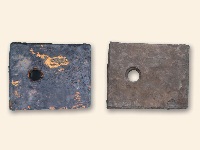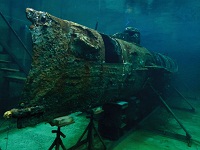spin-off science
stories by Frank Stephenson
In addition to the subcritical treatment of archeological iron, Clemson research on the Hunley archeology project has produced two other promising spin-off technologies:

Stéphanie Cretté, an expert in protective coatings used for artifacts found in marine environments, is the Lasch Center’s chief research scientist. She's also coordinating research on determining the most effective coatings for iron artifacts at Fort Sumter and Fort Moultrie. Image courtesy of Ray Stanyard.
- Greener Silicon Etching: Before silicon wafers can be used to build photovoltaic cells for solar panels or for use in microelectronics, their surfaces must be etched. Etching is commonly done using a wet process whereby silicon is bathed in a corrosive liquid of some kind. While highly efficient, the process typically generates large quantities of toxic waste. Using the Lasch Center’s know-how on subcritical technology, a team led by chemical engineer Nestor G. Gonzalez-Pereyra has developed an application for wet etching silicon that uses only a fraction of the volume of chemicals normally required. Gonzalez-Pereyra worked with Thompson Mefford, an expert on the chemistry of rust.
- Protection and Conservation of National Monuments: Thanks to an agreement with the National Park Service, Lasch Center researchers are transferring some of the cutting-edge digital imaging and corrosion-fighting techniques to help protect and conserve the grounds and artifacts at nearby Fort Sumter and Fort Moultrie. Last year, archaeologist Ben Rennison and Michael Scafuri, the center’s 3-D scanning specialists, in collaboration with Clemson civil engineers Sezer Atamturktur and Peter Messier, began analyzing the forts, inside and out, as part of a comprehensive structural assessment. The forts may be threatened by a federal plan to deepen channels at major ports in anticipation of an expansion of the Panama Canal. Concurrently, the center’s chief research scientist, Stéphanie Cretté, is coordinating research on determining the most effective industrial coatings for protecting the large collection of iron artifacts at both forts.
The Office of Technology Transfer in the Clemson University Research Foundation manages inventions described in these pages.
–
Museums throughout the world groan beneath the weight of iron artifacts recovered from the sea.
A submarine that made history delivers another potent payload, this time for science.
–




